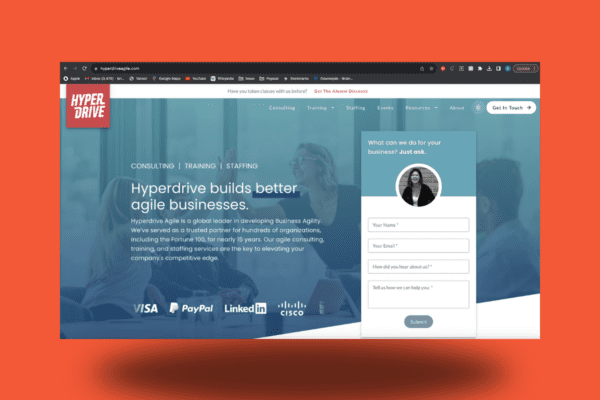Best Practices for Website Images: How to Make Your Photos Work for SEO and Conversions
Your website might have stunning visuals, but if your images aren’t optimized properly, they could be slowing your site down, hurting your search engine rankings, and missing a huge opportunity to boost engagement. Great web design isn’t just about how your site looks—it’s about how it performs. And images are a big part of that performance.
Whether you’re a small business, creative entrepreneur, or marketing team looking to elevate your online presence, it’s time to get strategic about your website imagery. Let’s talk about how to make your photos work harder—for both SEO and conversions.

1. Choose the Right Image Format
Not all image file types are created equal. Each one has a different use case:
- JPEG (or JPG): Great for photos and images with lots of color gradients. It’s compressed and loads quickly.
- PNG: Supports transparent backgrounds, best for logos or graphics with sharp edges—but larger in file size.
- WebP: A newer, SEO-friendly format supported by most browsers. WebP offers smaller file sizes with high quality, helping your pages load faster.
- SVG: Perfect for icons and simple graphics. It’s scalable without losing quality.
Pro Tip: If you’re still uploading only JPEGs and PNGs, look into WebP conversions for a quick SEO boost.
2. Compress Your Images Without Losing Quality
Page speed is a ranking factor in Google’s algorithm. Large, uncompressed images are one of the most common reasons websites load slowly.
Use tools like:
These tools compress your images without sacrificing visual quality. If you’re on WordPress, plugins like ShortPixel or Smush can handle this automatically.
3. Use Descriptive, Keyword-Rich File Names
Before uploading any image to your website, rename the file to something relevant and keyword-friendly. Instead of IMG_4871.jpg, name your image something like detroit-brand-design-studio.jpg.
This helps search engines understand what the image is about and improves your site’s SEO.
Example:
Bad: photo1.png
Good: website-design-detroit-healthcare-business.png
4. Write Alt Text That Works for SEO and Accessibility
Alt text (alternative text) serves two purposes:
- It makes your website more accessible for users with visual impairments (required for ADA compliance).
- It gives search engines more context about your images.
Best practices for alt text:
- Describe what’s in the image clearly and concisely.
- Include a relevant keyword where it naturally fits.
- Avoid keyword stuffing.
Example:
“Custom packaging design for Detroit-based skincare brand, featuring clean minimalist branding and warm neutral tones.”
5. Use Captions and Surrounding Text Strategically
Search engines like Google don’t “see” images—they rely on context. So your image’s alt text, file name, surrounding copy, and even captions all contribute to how that image is understood and indexed.
If an image is related to a service you offer (e.g., branding, website design, or content creation), make sure the accompanying text includes strategic keywords related to that service.
6. Create an Image Sitemap
If images are an important part of your website (hello, creative professionals!), consider creating an image sitemap. This tells Google where your images live and helps them appear in Google Image Search—an underrated source of traffic.
If you use WordPress + Yoast SEO or RankMath, they can generate this automatically for you.
7. Don’t Forget Mobile Optimization
Over half of all website traffic comes from mobile. That means your images must look great and load quickly on mobile devices, too.
Best practices include:
- Use responsive image settings (so they scale appropriately).
- Test mobile load speed with tools like Google PageSpeed Insights.
- Ensure no text is embedded in images that becomes unreadable on small screens.
8. Use Original Images Whenever Possible
Stock photography is fine in moderation, but original photography or custom graphics will always perform better. They’re more engaging, more trustworthy, and better for SEO (since they’re unique to your site).
If you’re a service provider, show off:
- Your team
- Behind-the-scenes content
- Client projects
- Branded product shots
Need help with visuals? At Mash Creative Co., we help our clients plan and create branded photo and content libraries that align beautifully with their messaging and design.
9. Use Image Placement to Drive Action
Beyond SEO, your images should support your conversion goals. That means placing visuals:
- Next to CTAs
- In service or portfolio sections to reinforce credibility
- In testimonial blocks to humanize the message
Well-placed visuals improve time-on-site, build trust, and subtly guide the user through the site experience.
In Summary: Apply Best Practices for Website Images
Website imagery is more than decoration—it’s an opportunity to support your SEO, elevate your brand, and turn visitors into customers. By following these best practices, your images will not only look great but perform with purpose.
Want help making sure your website visuals are SEO-ready and strategically placed? At Mash Creative Co., we specialize in design that blends beauty with performance. Whether you need a website refresh, content strategy, or custom photography—we’ve got you.
Let’s chat about how we can make your website work harder for you.



